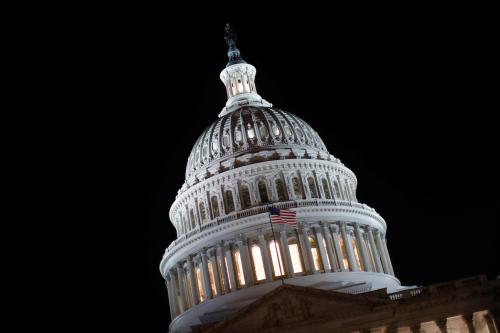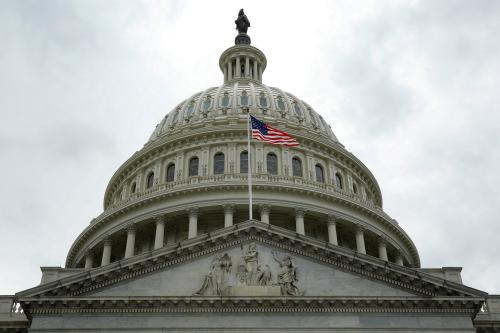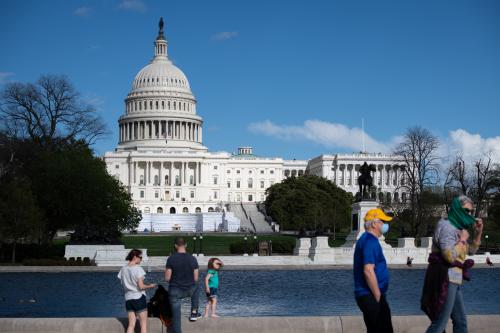No element of the relationship between the two ends of Pennsylvania Avenue has received more attention than the prospects for bipartisan legislative action on President Biden’s priorities. In Biden’s first 100 days, the administration has a major legislative achievement—the American Rescue Plan—on the books. Will additional major legislative wins follow?
Throughout the 2020 campaign and the transition alike, Biden maintained that congressional Republicans would change their tune and work with him to move legislation on a bipartisan basis. While an effort by Republicans to get the Trump administration’s support for an initial round of relief legislation in January was dismissed by the president and congressional Democrats as too small—indeed, the $618 billion proposal was only about a third of what Democrats were ultimately about to pass in the American Rescue Plan—Biden has continued to engage with congressional Republicans. On the proposed American Jobs Plan, for example, the administration, Biden said recently, is “prepared to negotiate as to the extent of the infrastructure project, as well as how we pay for it.”
On one hand, this is not notable; while Democrats enjoy unified partisan control of Washington, they do so by very slim margins, and the persistence of the Senate filibuster means that anything that can’t be handled through special, obstruction-proof procedures like the reconciliation process will need 60 votes to end debate. And even the reconciliation process is not unlimited; the rules governing the use of those expedited procedures limit the kinds of policy changes that can be made without the threat of a filibuster. (For example, the Senate Parliamentarian advised that an increase to the federal minimum wage was not permitted under the rules used to pass the American Rescue Plan.)
But at the same time, the fact that Biden and congressional Democrats have a legislative agenda that hopes to touch areas the reconciliation process cannot reach stands in contrast to Republicans’ approach to legislating four years ago. In 2017, when Republicans found themselves holding unified control of Washington, they turned to the reconciliation process immediately to move two specific priorities central to the party’s platform: repealing the Affordable Care Act and cutting taxes. (A third major focus of Republican efforts in Congress in the first two years of the Trump administration—confirming federal judges, which had significant but constrained effects on the overall federal judiciary—was also protected from the Senate’s usual 60-vote threshold.) This difference in the parties’ legislative agendas and in how they want to use Congress’s limited floor time is one of the most important dynamics shaping the early days of the Biden administration’s work with Congress.
Comparing the first major legislative priorities of the Biden and Trump administrations illustrates another important dynamic in congressional-executive relationships: the role of the president in legislative negotiations. Beginning before he was sworn in, President Trump was often a destabilizing force in that legislative process, rather than a productive one. (This dynamic extended beyond the ACA repeal debate and, perhaps most consequentially, was a major contributor to the record-breaking partial government shutdown in late 2018 and early 2019.) Four years later, by contrast, Democrats succeeded where Republicans failed in enacting their first major legislative priority, and Biden’s identification with the proposal may have helped get it across the finish line. Media accounts emphasized how Democrats were “aware of how [failure] would rattle Biden’s presidency and Democrats’ ability to be productive during this Congress.”
Importantly, it is not just that the White House is a stable player in legislative negotiations—it’s also that, as in administrations prior to Trump’s, it is seen as a key agenda setter in the policy process. While Trump repeatedly promised that a health care plan and an infrastructure proposal were forthcoming, offering detailed policy ideas that Congress could use as the basis for subsequent action was not a major strength of his administration. Biden’s early legislative proposals—like those of his recent predecessors Presidents Obama and Bush—have been seen as an important initial benchmark to inform subsequent negotiations within Congress and between the branches.
How much of Biden’s plans congressional Democrats ultimately take up, and in what form, remains to be seen; Congress certainly has a long history of working its own will on legislative proposals offered even by presidents of their own party early in their terms. Indeed, in the coming months, Biden’s legislative ambitions may be checked by a combination of divisions within his party in Congress and Senate rules—unless the Democratic Senate majority is willing to change them.
This work is licensed under the Creative Commons Attribution-NonCommerical-NoDerivatives 4.0 International License. To view a copy of the license, visit https://creativecommons.org/licenses/by-nc-nd/4.0/.







Commentary
Biden’s first 100 days in Congress
April 27, 2021